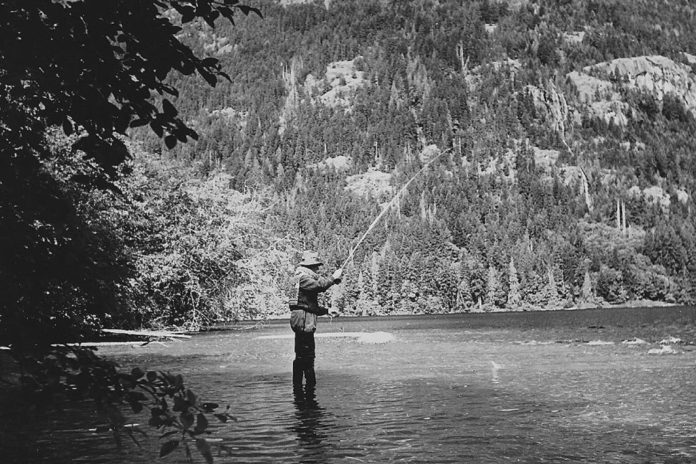Catherine Marie Gilbert, guest writer for the Museum
at Campbell River
This year, Strathcona Provincial Park celebrates its 110th anniversary and is a popular mecca for boaters, fishermen, hikers, mountaineers and naturalists.
Despite the importance of its stature as B.C.’s oldest provincial park, only certain segments of its history, such as the 1910 Ellison Expedition, have been well documented. From then until the 1950s, there has remained a rather murky period in which little was known about activities in the park.
I often thought of this period as the ‘Dark Ages’ of Strathcona Park history, and indeed, the park was too far away from populated areas to concern the provincial forestry service that oversaw it. Yet in the 1920s and ‘30s, certain individuals were well aware of the park’s natural assets, and these included a few “trespassers” who erected cabins around the lake and trapped, hunted and fished there, and a wealthy American lawyer, Louis Titus and his wife Alicia, who built several comfortable cabins on a mineral claim they owned on the west side of the lake near the Wolf River.
It isn’t known when Titus first acquired the property he called Camp Alicia, but by 1935, the family had engaged Jim Forbes of Forbes Landing to operate their holdings as a holiday camp. In the meantime, Titus invited fellow American William Reid, an oil entrepreneur, to see it. After one visit, Reid fell in love with the location and in 1936, purchased Camp Alicia. He then began flying up to Buttle Lake from his home in California in his Seabee float plane in order to spend summer months there.
The site, renamed Nootka Lodge, soon became a favourite destination for Reid and his family with children, cousins, nieces and nephews, aunts and uncles all taking turns visiting from the United States; transported there at Reid’s own expense. Reid’s daughter Virginia took numerous photos over the 18-year period that the Reid family owned the property, and her visual documentation offers a rare glimpse into life on the lake throughout the 1930s, ‘40s and early ‘50s.
Reid was an avid fisherman, and in many photos he is seen with fly rod in hand, either standing at the water’s edge or heading off in his small skiff, sometimes alone but often with others who shared his passion for catching trout. Reid kept a library that contained Roderick Haig-Brown’s books on fly fishing, and he was acquainted with Haig-Brown’s conservationist leanings. Reid was a determined protector of wildlife and in Alberta, where he had attended university, he purchased several acres of wetlands in order to preserve them for water fowl habitat, and established a Canadian branch of Ducks Unlimited.
In 1939, Reid began a correspondence by letter with Haig-Brown. He remarked how much he admired Haig-Brown’s writing and asked for help finding out more about a logging operation he heard was going to commence around the northeast edge of Buttle Lake. Because this section was owned by the Elk River Timber company, it could be worked at any time. Reid was concerned about the visual aftermath of logging right up to the edge of the beautiful park.
His correspondence with Haig-Brown went on for over a decade, with the two friends exchanging information on activities around Buttle Lake. Later letters discussed plans by the BC Power Commission to build a dam at the lake. Both were deeply involved in the infamous “Battle for Buttle” and for five years beginning in 1951, fought to convince the commission to move the dam site to the adjacent Upper Campbell Lake.
They succeeded, but sadly, Reid missed the opportunity to celebrate, and passed away in April 1956 at the age of 65. Still, he was spared from witnessing his beloved Buttle Lake shoreline destroyed when old growth forest was logged off before the dam was completed. Subsequently, the lake level rose by 18 feet and in the process, his holdings and claim were submerged under water. Haig-Brown was heartbroken over the loss of the original beauty of Buttle Lake, sad to hear of the passing of his friend, and Haig-Brown’s daughter Mary said that he was depressed for about a year afterwards.
Of the several cabins that surrounded the lake at the time, only a small “trespasser’s” cabin located near Park headquarters survived for many years, before being dismantled by BC Park rangers in the 1990s. The ethereal beauty of untouched Buttle Lake, as beautiful in the early 1950s as it was in 1910, survives in the Reid family photos.
Like us on Facebook and follow us on Twitter
Catherine will be presenting on her new book about Strathcona Park’s history virtually on June 9 at 6:30 PM. For details and a zoom link go to www.crmuseum.ca
Campbell RiverLocal History
Credit: Source link






























